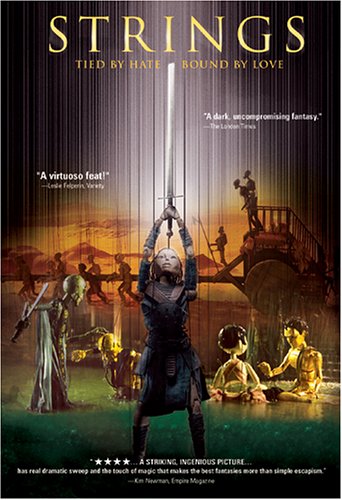 Strings. Dir. Anders Rønnow Klarlund. Perf. James McAvoy, Catherine McCormack, Julian Glover, Derek Jacobi, Ian Hart, Claire Skinner, David Harewood, and Samantha Bond. 2004. DVD. Fox Lorber, 2005.
Strings. Dir. Anders Rønnow Klarlund. Perf. James McAvoy, Catherine McCormack, Julian Glover, Derek Jacobi, Ian Hart, Claire Skinner, David Harewood, and Samantha Bond. 2004. DVD. Fox Lorber, 2005.Many years ago, I chanced on a reference to Strings: it claimed that the film was a version of Hamlet. Having finally had a chance to watch the film, I concede that there are some Hamletesque tangents in the film, but, overall, the Shakespeare allusions are minimal. Essentially, they amount to the basic narrative: The King is dead, and the son attempts to avenge his death while the uncle attempts to seize control of the kingdom. But there are innumerable differences, including the fact that this king took his own life (a fact that is concealed from his son in a plot to remove the son from the seat of power and to deprive him of life).
If you see this film, you should let it stand on its own merits without considering the Hamlet connection too deeply. After all, it's quite an innovative film! The film doesn't merely present marionettes presenting a drama; the entire world of the film is a marionette world, crafted to show what such a world would be like. For example, the city gates are designed so that the marionettes' strings are prevented from entering—if you keep the strings out, you keep the rest out.
And it's beautifully shot. Observe the dark, tragic opening of the film:
I suppose the easiest reference to make is Claudius' speech:
Note: According to the Wikipedia site, there's another Hamlet connection: the film is "a Danish-Swedish-Norwegian-British co-production." Denmark is, therefore, in both works. But there's more! Substituting "Polish" for "Swedish"—because Fortinbras leads his troops "Against some part of Poland" (IV.iv.12)—provides us with a description of Hamlet itself!Bow, stubborn knees; and, heart with strings of steel,
Be soft as sinews of the newborn babe!
All may be well. (III.iii.69-71)
Links: The Film at IMDB. The Wikipedia entry on the film.
Click below to purchase the film from amazon.com
(and to support Bardfilm as you do so).
(and to support Bardfilm as you do so).









No comments:
Post a Comment